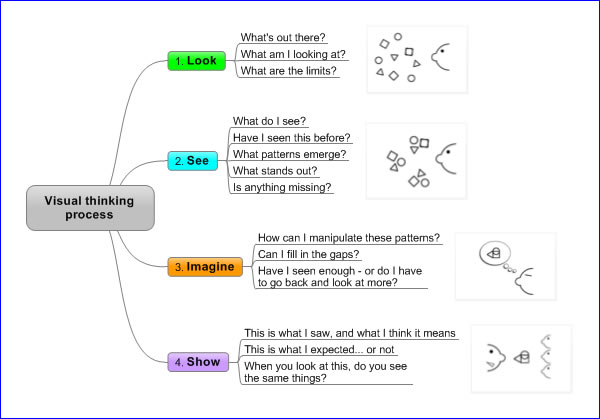Dan Roam, in his new book Unfolding the Napkin: The Hands-on Method for Solving Complex Problems with Simple Pictures, shares a series of questions that you can use to refine and improve your visual thinking. This simple process is very applicable to creating and refining the content of a mind map.
Step 1: Looking
The first step in the process is looking. What is the situation you are looking at and what are some ways in which it can be represented visually? At this stage you are defining the problem and establishing a frame around it. In other words, what is and what is not the problem? Record your thoughts as they occur to you but don’t give too much consideration to structure at this point in time.
Step 2: See
The second step in the process is when you look at what you have recorded in your visual map and start to make sense out of it. The three most important questions you can ask yourself at this stage are:
- What patterns do I see in the information I have recorded?
- What is missing?
- What stands out?
As you discern patterns, regroup map topics to join related items together. Don’t be afraid of experimenting; if a topic looks out of place where you moved it, use your program’s undo feature to move it back, or drag it to a different location.
As you group related items together, you may see holes in your mind map – sections where you need to add details in order to make your map more complete. Fortunately, that’s one of the key advantages of mind maps: They help us to develop a clearer and more complete picture and to fill in the blanks.
As you refine the content and structure of our mind map, you should also be developing a sense of what’s most important – what stands out. Now is the time to use your mind mapping program’s formatting tools to add visual emphasis to those key areas. You can do this by adding a boundary to a key topic and its subtopics. You can also use topic shapes, color and typography to differentiate these key elements of your mind map.
Step 3: Imagine
Where step 2, see, asks us to take a pragmatic look at the information we’ve gathered, step 3, imagine, requires us to step back and take a higher-level view of our mind map. For example, one of the key questions Roam recommends you ask yourself is, “How can I manipulate these patterns?” This implies that we’re viewing our mind map from such a high mental level that we can now see how individual patterns relate to each other. This, in turn, may help us to see other gaps in our information that need to be filled. It also begs the question, “Do I have enough information?” Do I need to conduct more research? Do I need to talk to subject matter experts to learn more?
Perhaps there are even some holes that you identified in step 2 where the information needed to fill it wasn’t readily available. Now is the time to gather it and put it into the proper places in our mind map.
By the end of step 3, you should have a complete mind map.
Step 4: Show
In this final step, you share your findings with others, and explain and what you think they mean – two different but related types of information that should be clearly differentiated from each other using color and/or font styles. One of the questions Roam asks (“This is what I expected… or not?”) implies that when you began your research, you began with a hypothesis. Your findings either validated it or not.
Not only do you use your visual map to communicate information to others in stage 4, Roam implies that you should also use it to open up a dialogue with them – “Are you seeing the same thing that I’m seeing?” This suggests that visual thinking can be a tool for helping to build shared understanding and consensus. I had never thought about a mind map in that context before, but it does make a lot of sense!
Conclusion
I think there’s a strong parallel between the simple process that Roam shared in Unfolding The Napkin and the iterative process of creating an effective mind map. Keep in mind the look, see, imagine and show process the next time you create a mind map, and I think you’ll end up with a better result!


Leave a Reply